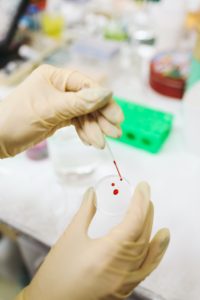
According to the CDC: The number of people living with Alzheimer’s Disease doubles every 5 years beyond age 65. This number is projected to nearly triple to 14 million people by 2060.
Diagnosing Alzheimer’s disease remains one of the most difficult challenges for the medical community. At this time, a diagnosis is not definitively confirmed until an autopsy of the brain can be performed. A few blood tests have slowly been making their way onto the market. But most are not yet available or reliable.
Although it is still in clinical trials, researchers at the University of Washington say their blood test detects signs of Alzheimer’s disease even years before symptoms develop.
The test is called SOBA, which stands for soluble oligomer binding assay. This process pinpoints toxic oligomers in the blood. Toxic oligomers are clusters of amyloid beta protein plaques most notably associated with a diagnosis of Alzheimer’s Disease.

Researchers look for whether biomarkers of Alzheimer’s Disease are present in the blood.
According to the study: SOBA detected oligomers in the blood of individuals with mild cognitive impairment and moderate to severe Alzheimer’s. In 53 cases, the research subject’s diagnosis of Alzheimer’s was verified after death by autopsy — and the blood samples of 52 of them, which had been taken years before their deaths, contained toxic oligomers. Notably, samples from a control group who remained free of cognitive impairment showed no toxic oligomers.
Senior study author and UW professor of bioengineering Valerie Daggett stated, “We believe that SOBA could aid in identifying individuals at risk or incubating the disease, as well as serve as a readout of therapeutic efficacy to aid in development of early treatments for Alzheimer’s disease.”
While this milestone is important, blood tests are not yet considered reliable diagnostic tools alone. According to a recent article in the Washington Post, at least three blood tests are available in most states outside clinical trials. However, most are not covered by insurance or readily offered by physicians. And more than one blood test is recommended for efficacy, as each targets specific markers. Other tests like spinal taps or PET scans are costly and/or invasive, so seldom prescribed.
Diagnosing Alzheimer’s disease continues to rely mainly upon symptom assessment and cognitive testing. Since these cognitive tests can be subjective, patients are often misdiagnosed. The desire to distinguish conclusive evidence of the disease is paramount to medical progress. Hence, the need for substantial diagnostic tools.

Blood tests may help doctors to determine whether biomarkers for AD are present in the blood years prior to symptom development.
It is estimated that 6.5 million people in the U.S. are living with AD. While these advancements in research may not affect their prognosis, these tests do hold promise for future generations. An earlier diagnosis allows families time to plan for future care. An ability to isolate and test for markers of the disease can also assist researchers in measuring successful outcomes for medications; even finding a potential cure. The Alzheimer’s Association recognizes the need for more research.
The final question comes down to whether diagnosing Alzheimer’s disease in advance is warranted. Younger or otherwise healthy patients may not want to know their risk of developing symptoms of AD in the future. There is no FDA-approved treatment to prevent Alzheimer’s. There are few medications proven to slow down symptoms. And there is no cure.

Some people may want to know if they have a high risk of developing symptoms of AD, so they can make immediate lifestyle changes.
But Leslie M. Shaw, a pathologist and Alzheimer’s researcher at the University of Pennsylvania, believes that knowing your risk can be a hugely positive motivator. Shaw told the Washington Post that this knowledge could spur us to “make the changes we now know are important. Instead of being a classic couch potato, get off your duff and get going.”
The National Institute on Aging offers details on the most promising preventative suggestions, including physical activity, blood pressure control, and cognitive training. Although none are proven methods to ward off AD, they have been shown to reduce cognitive decline overall.

 Diagnosing Alzheimer’s Disease Before It Strikes
Diagnosing Alzheimer’s Disease Before It Strikes



 How Dare You Die Now!
How Dare You Die Now!
 Debating Medical Aid in Dying
Debating Medical Aid in Dying














